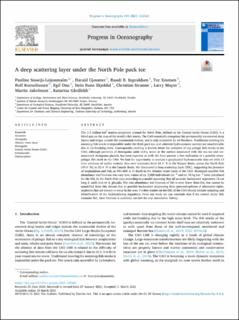| dc.contributor.author | Snoeijs-Leijonmalm, Pauline | |
| dc.contributor.author | Gjøsæter, Harald | |
| dc.contributor.author | Ingvaldsen, Randi Brunvær | |
| dc.contributor.author | Knutsen, Tor | |
| dc.contributor.author | Korneliussen, Rolf | |
| dc.contributor.author | Ona, Egil | |
| dc.contributor.author | Skjoldal, Hein Rune | |
| dc.contributor.author | Stranne, Christian | |
| dc.contributor.author | Mayer, Larry | |
| dc.contributor.author | Jakobsson, Martin | |
| dc.contributor.author | Gårdfeldt, Katarina | |
| dc.date.accessioned | 2021-08-18T13:01:46Z | |
| dc.date.available | 2021-08-18T13:01:46Z | |
| dc.date.created | 2021-07-20T08:27:30Z | |
| dc.date.issued | 2021 | |
| dc.identifier.citation | Progress in Oceanography. 2021, 194 . | en_US |
| dc.identifier.issn | 0079-6611 | |
| dc.identifier.uri | https://hdl.handle.net/11250/2770130 | |
| dc.description.abstract | The 3.3 million km2 marine ecosystem around the North Pole, defined as the Central Arctic Ocean (CAO), is a blind spot on the map of the world’s fish stocks. The CAO essentially comprises the permanently ice-covered deep basins and ridges outside the continental shelves, and is only accessible by ice-breakers. Traditional trawling for assessing fish stocks is impossible under the thick pack ice, and coherent hydroacoustic surveys are unachievable due to ice-breaking noise. Consequently, nothing is known about the existence of any pelagic fish stocks in the CAO, although juveniles of Boreogadus saida richly occur at the surface associated with the sea ice and ice-associated Arctogadus glacialis has been reported as well. We here present a first indication of a possible mesopelagic fish stock in the CAO. We had the opportunity to analyse a geophysical hydroacoustic data set with 13 time windows of usable acoustic data over a transect from 84.4 °N in the Nansen Basin, across the North Pole (90.0 °N), to 82.4 °N in the Canada Basin. We discovered a deep scattering layer (DSL), suggesting the presence of zooplankton and fish, at 300–600 m of depth in the Atlantic water layer of the CAO. Maximum possible fish abundance and biomass was very low; values of ca. 2,000 individuals km−2 and ca. 50 kg km−2 were calculated for the DSL in the North-Pole area according to a model assuming that all acoustic backscatter represents 15-cm long B. saida and/or A. glacialis. The true abundance and biomass of fish is even lower than this, but cannot be quantified from this dataset due to possible backscatter originating from pneumatophores of physonect siphonophores that are known to occur in the area. Further studies on the DSL of the CAO should include sampling and identification of the backscattering organisms. From our study we can conclude that if the central Arctic DSL contains fish, their biomass is currently too low for any sustainable fishery. | en_US |
| dc.language.iso | eng | en_US |
| dc.title | A deep scattering layer under the North Pole pack ice | en_US |
| dc.type | Peer reviewed | en_US |
| dc.type | Journal article | en_US |
| dc.description.version | publishedVersion | en_US |
| dc.source.pagenumber | 14 | en_US |
| dc.source.volume | 194 | en_US |
| dc.source.journal | Progress in Oceanography | en_US |
| dc.identifier.doi | 10.1016/j.pocean.2021.102560 | |
| dc.identifier.cristin | 1922155 | |
| dc.relation.project | Norges forskningsråd: 228896 | en_US |
| cristin.ispublished | true | |
| cristin.fulltext | original | |
| cristin.qualitycode | 1 | |
